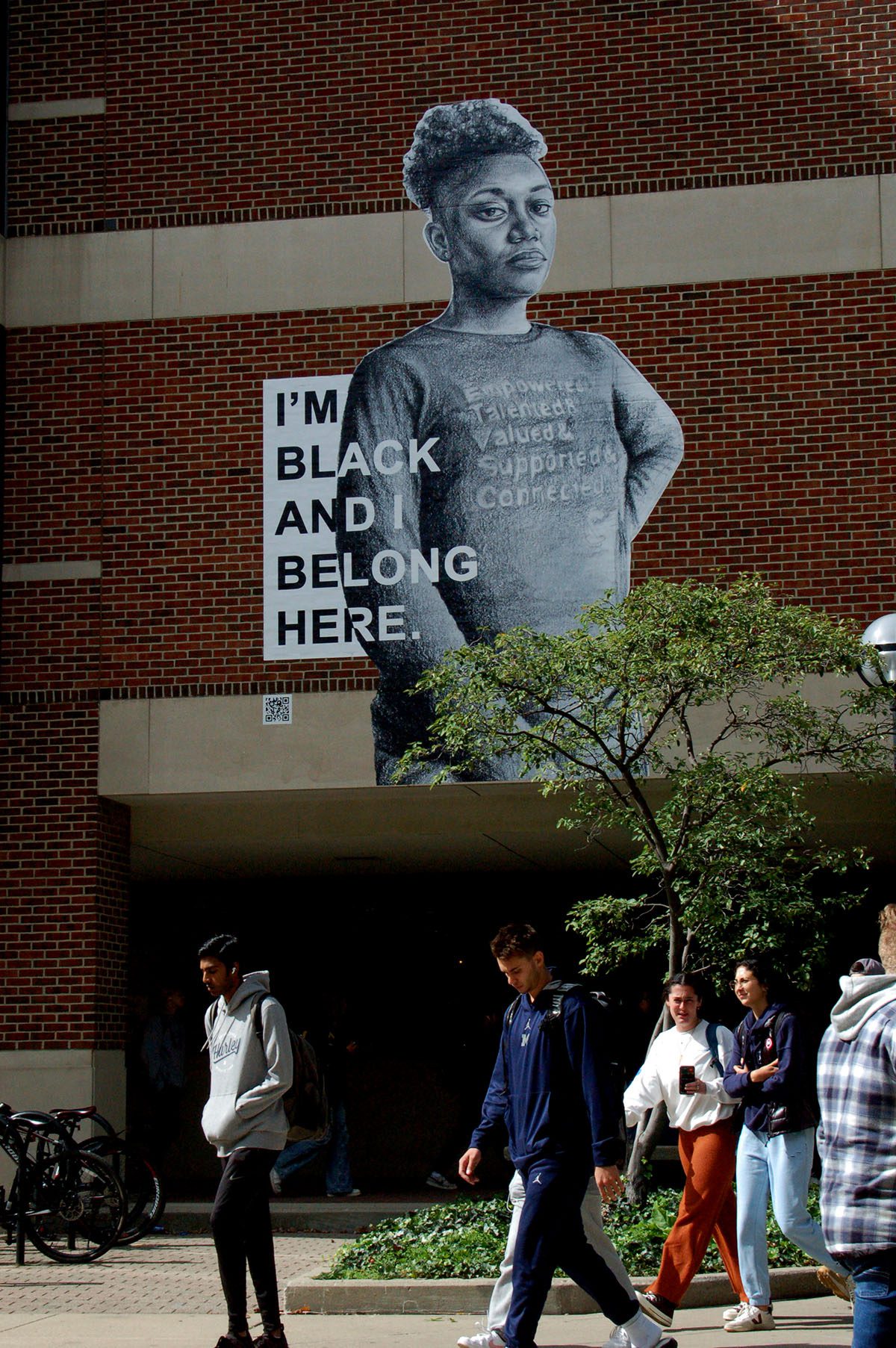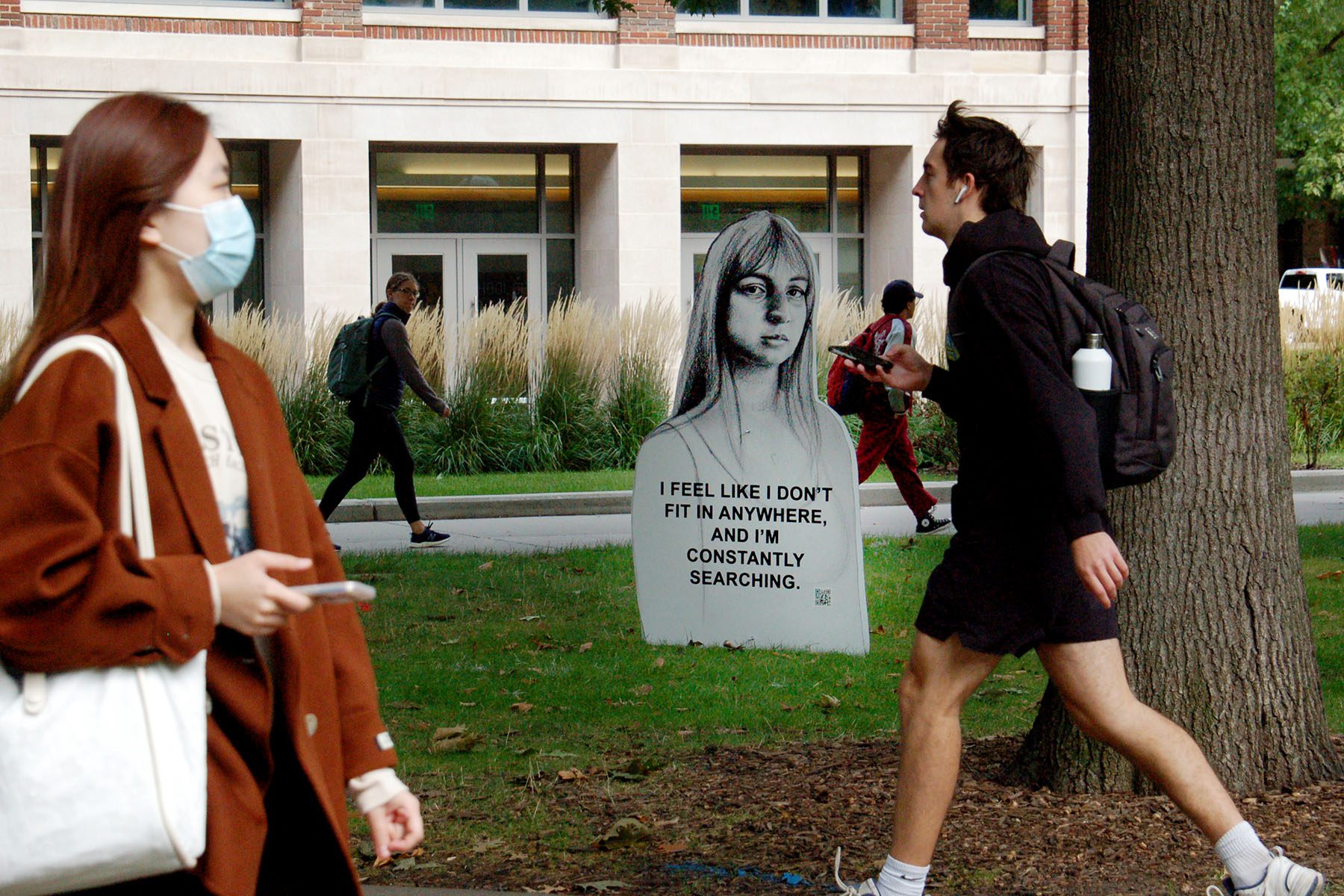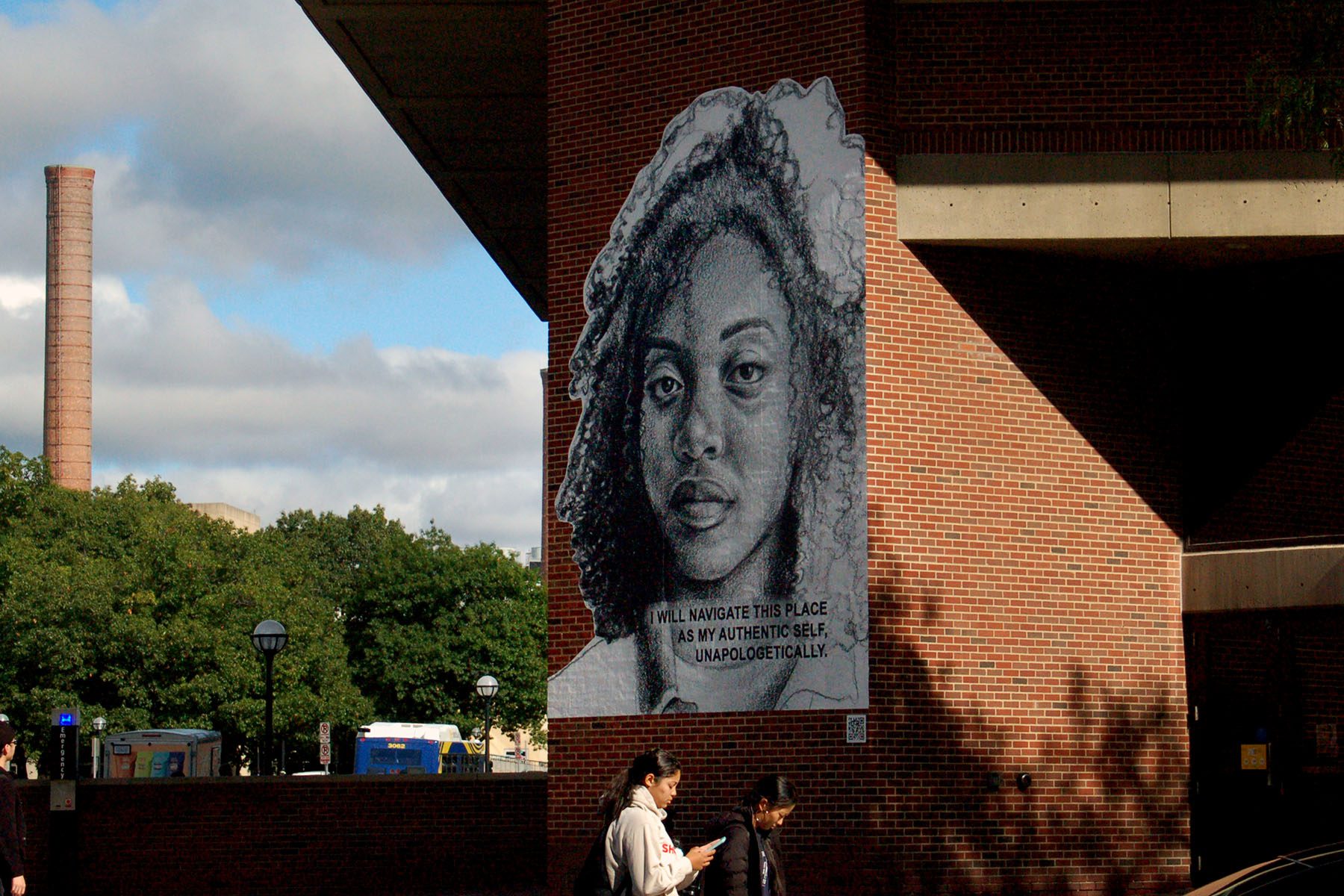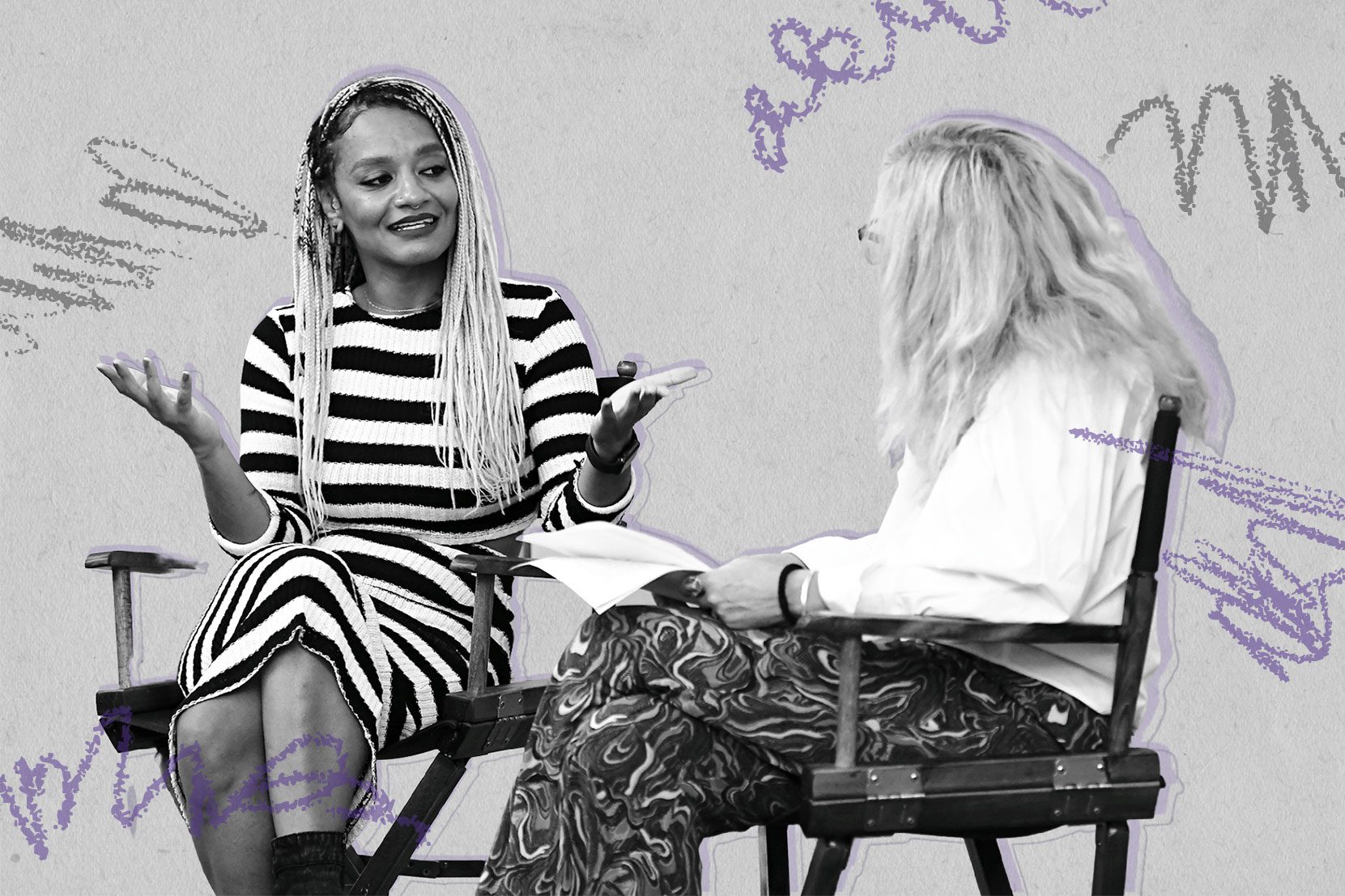Tatyana Fazlalizadeh’s art puts narrative back in the hands of people.
Most recently, the Brooklyn-based artist turned her attention to students at the University of Michigan, as part of a residency with work exhibited during September and October with the school’s Institute for the Humanities, to examine the way that women-identifying students experience college life as a result of their race and gender.
She visited classes, held seminars and opened her office to one-on-one interviews, asking “how overlapping identities can create a very particular experience” for students, especially women and women of color. “Where they come from, how they grew up, their race, gender, sexuality, how they present — these all translate into how they are treated in a public space. What I try to get at in my work is how people experience different environments and what they have to say about it.”
Those responses led to her latest installation: “To Be Heard,” a set of murals featuring the faces of six students that were displayed for two and a half weeks on the sides of major buildings on the University of Michigan campus. The murals appeared on campus from September 28 – October 16.
It is the kind of work she is best known for. Fazlalizadeh’s expansive murals use photo-realistic depictions of her subjects paired with their own words to explore gender and race. Since “Stop Telling Women to Smile,” a 2012 mural installation in Brooklyn about gender-based street harassment, Fazlalizadeh has refined her method of engaging people in in-depth, one-on-one conversations which she then translates and distills into large-scale public works.
About two years ago, the University of Michigan’s Institute for the Humanities invited Fazlalizadeh to Ann Arbor for a residency. One pandemic later, she finally arrived on campus last month, creating a series of works all meant to ask viewers to think about how women and people of color are allowed to experience both private and public spaces.
“I was interested in what it would mean to put real students’ faces on the walls of buildings we all know so well, to hear their words directly versus some kind of campaign,” Amanda Krugliak, director of the Institute for the Humanities, said. “We see images around DEI and other initiatives, but those are coming from a different place. This has an authenticity I appreciate. There are things we need to talk about openly in regards to race and gender, and this seemed like a project that could give this space, in a public space. I want to do projects that open up space for discussion and conversation and better the university.”

Fazlalizadeh’s first project of her residency, the multimedia gallery show “Pressed Against My Own Glass,” explored Fazlalizadeh’s understanding of Black womanhood in the home space. (Fazlalizadeh, 37, was born to a Black mother and Iranian father and raised in Oklahoma City.) For her second project, Fazlalizadeh created “To Be Heard,” an installation about the intersections of gender, race, sexual violence and public space at the University of Michigan.
According to the University of Michigan’s most recent Campuswide Diversity, Equity and Inclusion Climate Assessment from 2016, 65 percent of all students are White. Fifteen percent are Asian American, six percent are Hispanic, and only five percent are African American.
In addition to meeting with specific, pre-selected classes and facilitating large group conversations around these topics, Fazlalizadeh also hosted open office hours, where individuals could make appointments to sit and talk with her one-on-one. “I found that when they came in, they had a lot to say,” she said of the students who came to meet with her. “It just started pouring out of them. It was mostly Black students, some Brown folks, all students who identified as women. But they all had very different things to talk about that were particular to them.”
From this, Fazlalizadeh said she found some unexpected common threads — especially pertaining to how the pandemic has shaped students’ experiences now that they are not just physically on campus but also inhabiting its public spaces. “They talked about trying to find community, trying to find a safe space, not feeling supported by the university. Folks felt like they had to protect themselves against sexism and racism without the support of the institution. My work in this project has been trying to affirm other people, affirm Black folks and women to take care of themselves.”
Fazlalizadeh sees in public artwork a powerful method of not only amplifying the subject’s voice, but also affecting the people who interact with it. “You see this work and no matter who you are, it captures you and now you are a part of this conversation, whether you want to be or not,” she said. “You’re confronted with this person’s face and name and experience and voice whether you wanted to know them or not.”
For the six students who were ultimately selected for portraits displayed in these public murals, their faces and voices are now permanently part of a larger dialogue that will exist on campus about gender and race and space even after these works come down.
Taylor Johnson, 21, grew up in Detroit. She is a senior majoring in African-American studies and minoring in social change. As a young Black woman, she said the experience of holding these identities on campus has felt isolating and lonely.
Johnson initially met Fazlalizadeh through a focus group in an American Studies class. “I talked about being a Black woman on campus, going to a PWI [predominantly White institution]. When you go to a PWI, you have to find your safe spaces. It’s hard to not see people who look like you. The whole university should be a safe space, but it isn’t.”
“Michigan is a big school,” Johnson continued. “We have football and basketball, and that’s what everyone thinks about when they think of it. The student people think about being here is a White man. They don’t look like me. I don’t think people think about how hard it is to be a minority on campus. It’s intimidating when you walk into a classroom and everyone is White and then race comes up. Someone said to me once, ‘Don’t take up someone else’s space and not let them have a chance to talk,’ but I think that’s exactly what’s missing from a lot of people’s experiences here.”
The quote used on Johnson’s mural is, “I’m Black and I belong here.”
Johnson said she felt both “excited” and then worried about the mural of her. She said she has seen some tweets of people mocking the project, and the mural depicting her specifically. “I don’t want to see people laughing. I hope people stop and learn and understand that these images need to be seen. This is a huge moment for me to be my authentic self, for people to hear the things I say to my friends and family so often that they’re probably sick of hearing me say them, but that I wanted to say to others as well. I don’t have a lot of non-Black friends on this campus, but people need to know how I feel. Non-Black people need to know how we feel and how they make people feel in the classroom.”
Santana Malnaik, 19, is a junior art and design major who is minoring in political science and social class and inequality studies. Malnaik, who graduated from high school in 2020, entered college during the height of COVID. “There was a total lack of support, especially for students of color who are disproportionately impacted by COVID,” she said. “Starting college during a pandemic led to a lack of community, especially for students in my year. We’re juniors now, and this is our first full year on campus.”
Seeing the murals around campus has been impactful for Malnaik, whose mother is White and whose father is Indian. “We so seldom see Black and Brown faces highlighted at the university unless it’s being done for PR, for the university to profit. The Brown population on campus is miniscule compared to the White population. It’s hard to make a Brown student feel comfortable if you’re the only one in class.”
Malnaik’s portrait bears the words, “I feel like I don’t fit in anywhere and I’m constantly searching.”
“My statement is an insecurity of mine,” Malnaik said. “I don’t really feel like I have a place. I’m always looking for a community I can feel comfortable in. Being half-White and half-Indian, I’m too Brown for the White kids and too White for the Brown kids. I feel out of place. I hope my portrait speaks to other students and helps them feel comfortable in trying to find a place where they belong, or to reach out and speak to someone new.”

Courtney Smith, 21, is a senior from Ann Arbor who is majoring in German and international studies. A White woman, Smith attended the same focus group as Johnson, during which students discussed what they saw as some of the biggest problems that existed at their school, and what they thought needed to be improved.
During their session, Smith said her class talked about two main topics: the lack of support students of color feel from the administration, and the prevalence of sexual assault on campus and a perceived lack of intervention on behalf of the university to change this.
“I talked about how women on this campus don’t feel safe because men are allowed to go unchecked,” Smith said.
Smith’s best friend was raped at a fraternity party in the winter of 2020, and when she reported her assault to the university, she ultimately didn’t feel comfortable moving forward in their investigative process “because it was so invasive and involved peer review.” (In October 2021, the University of Michigan implemented a new system for Title IX investigations into incidences of sexual misconduct; this new system eliminated the peer review process, instead moving into a hearing system with a neutral third party.)
Smith’s experiences with sexual violence on campus didn’t end there. Her little sister attended a party where a large bowl of drinks was drugged. “Everyone at that party got roofied, and nothing ever happened to the fraternity that did that. These feel like pretty big issues to ignore,” Smith said of how sexual violence has touched the lives of those she cares most about on campus. “It was just very disappointing.” Smith said further research into campus sexual assault led her to learn that the Univeristy of Michigan’s statistics are worse than the national average, 34 percent of female students they experienced nonconsensual touching or penetration while on campus, compared to 26 percent of undergraduate students nationwide who say they have experienced rape or sexual assault through physical force, violence, or incapcitation.
During her conversation with Fazlalizadeh, Smith said, “I raged against the machine for 20 minutes. I said women are not safe on campus, that the university doesn’t provide activities for people to go to other than fraternity parties where alcohol is involved and young women are put at risk. She asked me questions like if the university should do anything to change, how I thought the university was failing and could better support people on campus. We talked about possible solutions.”
Smith first saw the final work depicting her face and words in a text message from her sister. “‘Is this you?’ she asked me. It’s a beautiful picture. [Fazlalizadeh] made me feel very strong. The words she put next to my face were things younger me would have wanted to say but wouldn’t have had the courage to say.”
The mural of Smith bears the words, “Where is the protection for women? Stop letting men get away with sexual misconduct.”
The timing of this project feels of particular importance to Fazlalizadeh. “It shows how angry young people still are in this particular moment,” she said. “This experience is unique to coming out of these past two years and the really personal effect it has had on young people, and right now, they’re also really experiencing sexual harassment, racial aggression, they’re really trying to hold the weight of everything and trying to figure all these things out while also having to go to class in the morning.”
“It feels like in this moment, things should not go back to being the same,” Krugliak said. “There is this pressure to move forward and produce and move to the next step now that the pandemic is behind us, but it feels like the response should be something that creates something new. It feels imperative to be responsive.”
She talked about the importance of Fazlalizadeh’s art in that regard: “The temporary nature of her work speaks to that process. It is not about one day or one action. It’s a long road. It is empowering, but also fragile.”

Working with students at the University of Michigan in such an intimate way has been a unique experience for Fazlalizadeh, one that has brought forth a different set of feelings than those she said she often feels in her own work. “I’m not a peace-and-love kind of person. I lean more towards the angry side, and my work explores that more. But doing this project, I’ve noticed a lot of my own sentiments have been on making sure that people are good and OK.”
“Over the years, I have gotten a little pessimistic. It’s harder to think about larger systems and how to dismantle systems that are abusive and silent, especially to women and especially to non-White women. What I have to focus on is how to look at the individual experiences that happened to a person,” Fazlalizadeh continued.
This residency at the University of Michigan has given her a new opportunity to engage in the methodology behind her work in a new light. “I have to do a sort of holistic look at this person in front of me, what they’re feeling, how they’ve been affected emotionally, physically and spiritually. What they carry with them if they experience sexism or racism. My work tries to give a voice and a space to that person. The thing is, they already have a voice, so I don’t need to give them that. But I can give them space.”







